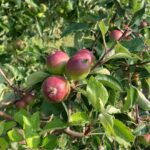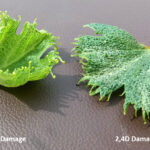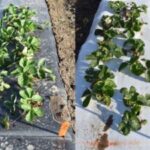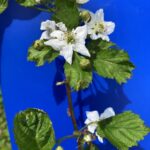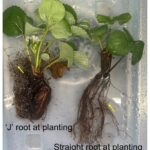Hi. As I’m sure most of you have noticed, the Japanese Beetles have arrived. We have been dealing with them in every fruit crop with the exception of our apples. The blackberries are currently being consumed by them despite a well-timed spray last week. Fire blight continues to show up in our orchard. We are[Read More…]
Crop Management
From 2022 to 2024, we evaluated the performance of 15 June-bearing strawberry cultivars grown in a plasticulture system using black and white-on-black plastic mulches at two locations in Indiana: the Southwest Purdue Agricultural Center in Vincennes, IN, and the Meigs Horticulture Research Farm in Lafayette, IN. During the experimental period, monthly average temperatures at the[Read More…]
This is the time of year where we receive numerous reports of off-target herbicide exposure. Grapevines and fruit trees sensitive to growth regulator herbicides, including phenoxy, benzoic, and pyridine classes of compounds. 2,4-D and dicamba are the most common products, and they are used widely in corn and soybean production. Damage can range from minimal[Read More…]
The window for chemical thinning is rapidly closing in many parts of the state. Carbaryl can be effective up to 20 mm fruit diameter. After this stage, options become limited and we’re in a “rescue thinning” approach. Below is some information from Penn State University on rescue thinning options: Rescue Thinning Options – 20mm and[Read More…]
From 2022-2024, we evaluated the performance 15 strawberry cultivars grown in plasticulture system using black and white-on-black plastic mulches (Figure 1) at two locations: Southwest Purdue Agricultural Center in Vincennes, IN (USDA hardiness zone 6b), and Meigs Purdue Agricultural Center in Lafayette, IN (USDA hardiness zone 6a). Strawberries were harvested for two seasons. Plug plants[Read More…]
Hi! This week’s crop conditions are looking quite good despite not having any significant rain recently. Most crops have set fruit and are progressing well. The grapes received their second spray this season on the 9th. This is a busy time here at Meigs as we make raised beds for our vegetable crops and prepare[Read More…]
Spring is in full swing in our research high tunnels at Purdue. Overwintering strawberries that we planted in September are now in full bloom and fruits are being harvested. But as temperatures increase and crops become more productive, we also see the emergence of various insect pests. Aphids, amongst other soft-bodied insect pests (e.g., whiteflies,[Read More…]
Bare-root strawberry plants often arrive with roots that are 6 to 10 inches long. For optimal planting, the roots should be kept straight, which requires digging a deep hole or using specialized tools. If the planting hole is too shallow, the roots may bend and form what is known as a ‘J-root’. You may have[Read More…]
Interested in planting brambles? Here’s what you need to know! What are brambles? Bramble crops are from the genus Rubus and include blackberries and raspberries. Brambles are among the easiest fruit crops to grow, and the fruit is in high demand due to its exotic flavor and high nutritional value. Brambles can be planted in[Read More…]

